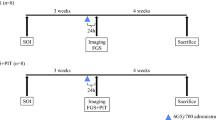Abstract
Background
Photoimmunotherapy (PIT) uses a target-specific photosensitizer based on a near-infrared (NIR) phthalocyanine dye, IR700, to induce tumor necrosis after irradiation with NIR light to kill cancer cells, such as those that remain after surgery. The purpose of the present study was to sterilize the surgical bed after pancreatic cancer resection with PIT in carcinoembryonic antigen (CEA)-expressing, patient-derived, orthotopic xenograft (PDOX) nude mouse models.
Methods
After confirmation of tumor engraftment, mice were randomized to two groups: bright light surgery (BLS)-only and BLS + PIT. Each treatment arm consisted of seven tumor-bearing mice. BLS was performed under standard bright-field with an MVX10 long-working distance, high-magnification microscope on all mice. For BLS + PIT, anti-CEA antibody conjugated with IR700 (anti-CEA-IR700) (50 µg) was injected intravenously in all mice 24 h before surgery. After the surgery, the resection bed was then irradiated with a red-light-emitting diode at 690 ± 5 nm with a power density of 150 mW/cm2.
Results
Anti-CEA-IR700 labelled and illuminated the pancreatic cancer PDOX. Minimal residual cancer of the PDOX was detected by fluorescence after BLS. The local recurrence rate was 85.7 % for BLS-only and 28.6 % for BLS + PIT-treated mice (p = 0.05). The average recurrent tumor weight was 1149.0 ± 794.6 mg for BLS-only and 210.8 ± 336.9 mg for BLS + PIT-treated mice (p = 0.015).
Conclusion
Anti-CEA-IR700 was able to label and illuminate a pancreatic cancer PDOX nude mouse model sufficiently for PIT. PIT reduced recurrence by eliminating remaining residual cancer cells after BLS.




Similar content being viewed by others
References
Kato K, Yamada S, Sugimoto H, et al. Prognostic factors for survival after extended pancreatectomy for pancreatic head cancer: influence of resection margin status on survival. Pancreas. 2009;38(6):605–12.
Mitsunaga M, Ogawa M, Kosaka N, Rosenblum LT, Choyke PL, Kobayashi H. Cancer cell-selective in vivo near infrared photoimmunotherapy targeting specific membrane molecules. Nat Med. 2011;17(12):1685–91.
Maawy A, Hiroshima Y, Zhang Y, et al. Near infra-red photoimmunotherapy with anti-CEA-IR700 results in extensive tumor lysis and a significant decrease in tumor burden in orthotopic mouse models of pancreatic cancer. PLoS One. 2015;10(3):e0121989.
Fu X, Guadagni F, Hoffman RM. A metastatic nude-mouse model of human pancreatic cancer constructed orthotopically with histologically intact patient specimens. Proc Natl Acad Sci U S A. 1992;89(12):5645–9.
Furukawa T, Kubota T, Watanabe M, Kitajima M, Hoffman RM. A novel “patient-like” treatment model of human pancreatic cancer constructed using orthotopic transplantation of histologically intact human tumor tissue in nude mice. Cancer Res. 1993;53(13):3070–2.
Hoffman RM. Orthotopic metastatic mouse models for anticancer drug discovery and evaluation: a bridge to the clinic. Invest New Drugs. 1999;17(4):343–59.
Yamauchi K, Yang M, Jiang P, et al. Development of real-time subcellular dynamic multicolor imaging of cancer-cell trafficking in live mice with a variable-magnification whole-mouse imaging system. Cancer Res. 2006;66(8):4208–14.
Astoul P, Colt HG, Wang X, Hoffman RM. Metastatic human pleural ovarian cancer model constructed by orthotopic implantation of fresh histologically-intact patient carcinoma in nude mice. Anticancer Res. 1993;13(6A):1999–2002.
Fu X, Hoffman RM. Human ovarian carcinoma metastatic models constructed in nude mice by orthotopic transplantation of histologically-intact patient specimens. Anticancer Res. 1993;13(2):283–286.
Fu X, Le P, Hoffman RM. A metastatic orthotopic-transplant nude-mouse model of human patient breast cancer. Anticancer Res. 1993;13(4):901–904.
Fu XY, Besterman JM, Monosov A, Hoffman RM. Models of human metastatic colon cancer in nude mice orthotopically constructed by using histologically intact patient specimens. Proc Natl Acad Sci U S A. 1991;88(20):9345–9349.
Hiroshima Y, Zhang Y, Zhang N, et al. Establishment of a patient-derived orthotopic xenograft (PDOX) model of HER-2-positive cervical cancer expressing the clinical metastatic pattern. PLoS One. 2015;10(2):e0117417.
Togo S, Shimada H, Kubota T, Moossa AR, Hoffman RM. Host organ specifically determines cancer progression. Cancer Res. 1995;55(3):681–684.
Wang X, Fu X, Hoffman RM. A new patient-like metastatic model of human lung cancer constructed orthotopically with intact tissue via thoracotomy in immunodeficient mice. Int J Cancer. 1992;51(6):992–995.
Mitsunaga M, Nakajima T, Sano K, Choyke PL, Kobayashi H. Near-infrared theranostic photoimmunotherapy (PIT): repeated exposure of light enhances the effect of immunoconjugate. Bioconjug Chem. 2012;23(3):604–9.
Yamaguchi K, Enjoji M, Tsuneyoshi M. Pancreatoduodenal carcinoma: a clinicopathologic study of 304 patients and immunohistochemical observation for CEA and CA19-9. J Surg Oncol. 1991;47(3):148–54.
Xu C, Sun Y, Wang Y, et al. CEA promoter-regulated oncolytic adenovirus-mediated Hsp70 expression in immune gene therapy for pancreatic cancer. Cancer Lett. 2012;319(2):154–63.
Acknowledgment
This study was supported in part by National Cancer Institute grants CA132971 and 142669 (to Michael Bouvet and AntiCancer, Inc.) and JSPS KAKENHI Grant Numbers 26830081 to Yukihiko Hiroshima, 26462070 to Itaru Endo and 24592009 to Kuniya Tanaka.
Author information
Authors and Affiliations
Corresponding author
Additional information
Yukihiko Hiroshima and Ali Maawy have contributed equally to this work.
Electronic supplementary material
Below is the link to the electronic supplementary material.
10434_2015_4553_MOESM1_ESM.tif
Supplemental Figure 1. Image of photoimmunotherapy (PIT) in a mouse after resection of orthotopic pancreatic cancer. (TIFF 1674 kb)
10434_2015_4553_MOESM2_ESM.tif
Supplemental Figure 2. Characterization of the patient-derived pancreatic tumors. Both SDXPC1 and SDXPC2 were diagnosed as moderately differentiated adenocarcinoma with H & E staining (A and C). SDXPC2 was strongly stained with anti-CEA antibody (D), but the signal was minimally detected in SDXPC1 (A). Scale bars: 100 μm. (E - H) Whole body images of subcutaneous pancreatic tumors labeled with anti-CEA-IR700. Anti-CEA-IR700 (50 μg) was injected from the tail vain of the mice with subcutaneous SDXPC1or SDXPC2 tumors. Twenty-four hours later, whole body images were obtained with the OV100 (Olympus). Yellow arrow heads indicate subcutaneous tumors. SDXPC2 was brightly labeled with anti-CEA-IR700 (H), but the specific fluorescence signal from SDXPC1 labeled with anti-CEA-IR700 was minimally detected (F). Scale bars: 10 mm (TIFF 7708 kb)
Rights and permissions
About this article
Cite this article
Hiroshima, Y., Maawy, A., Zhang, Y. et al. Photoimmunotherapy Inhibits Tumor Recurrence After Surgical Resection on a Pancreatic Cancer Patient-Derived Orthotopic Xenograft (PDOX) Nude Mouse Model. Ann Surg Oncol 22 (Suppl 3), 1469–1474 (2015). https://doi.org/10.1245/s10434-015-4553-9
Received:
Published:
Issue Date:
DOI: https://doi.org/10.1245/s10434-015-4553-9




